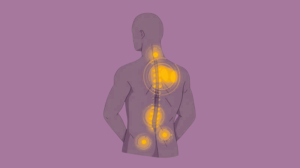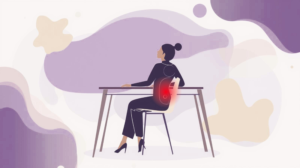Back pain has become an increasingly common issue, especially among individuals who spend long hours sitting, whether at a desk, in front of a screen, or in traffic. One practical and science-backed solution is the use of ergonomic lumbar cushions. Designed to support the natural curve of the spine, these cushions provide more than just comfort, they promote better posture, reduce discomfort, and improve overall spinal health.
What Is an Ergonomic Lumbar Cushion?
An ergonomic lumbar cushion is specifically designed to support the lower back’s natural curve. Unlike generic cushions or rolled-up towels, lumbar cushions target the lumbar spine, a key area for maintaining healthy posture. By filling the gap between your lower back and the chair, they prevent slouching, minimize strain, and reduce the risk of developing musculoskeletal disorders.
Common Materials Used (Memory Foam, Gel, etc.)
The effectiveness of a lumbar cushion largely depends on the materials used:
- Memory Foam: Adapts to the shape of your body, offering personalized support.
- Gel-Infused Foam: Enhances comfort and breathability, reducing heat buildup.
- Mesh Fabric: Promotes air circulation and reduces sweating during extended use.
- Orthopedic-Grade Foam: Provides firm support ideal for individuals with chronic back issues.
How Lumbar Cushions Work on the Spine?
The lumbar region consists of five vertebrae (L1-L5) located in the lower back. This area supports much of the upper body weight and is naturally curved inward. Poor posture flattens this curve, leading to discomfort and potential damage over time.
Role in Posture Correction
A lumbar cushion helps to maintain the spine’s natural curve, encouraging proper alignment from the pelvis to the neck. By providing targeted support, it gently nudges the body into a healthier sitting position, reducing slouching and forward head posture.
Pressure Distribution and Muscle Relaxation
Ergonomic cushions help distribute body weight evenly across the spine and hips. This alleviates pressure points, reducing fatigue and allowing muscles to relax. Over time, this leads to decreased muscle tension and improved comfort during extended sitting periods.
Scientific Benefits of Using Lumbar Cushions
Reduction of Lower Back Pain
Numerous studies have shown that lumbar support cushions can significantly reduce lower back pain, especially in people who sit for extended periods. By preserving the natural lumbar curve, these cushions reduce mechanical stress on the spine.
Improved Circulation and Comfort
Sitting with poor posture can compress blood vessels, reducing circulation. Ergonomic lumbar cushions open up the hips and lumbar region, improving blood flow and reducing leg numbness or tingling.
Enhanced Productivity from Proper Seating
A comfortable posture enhances focus, reduces discomfort, and leads to higher productivity. This is especially important for remote workers and office employees who spend 6-8 hours seated daily.
Comparison: Lumbar Cushion vs Lumbar Roll
| Feature | Lumbar Cushion | Lumbar Roll |
| Shape | Contoured, wide | Cylindrical |
| Support Area | Full lower back | Small specific area |
| Best For | Long hours, office chairs | Short sessions, therapy exercises |
| Adjustability | High (straps & curves) | Medium |
| Comfort Level | High | Moderate |
| Ideal Use | Office, car, home | Physiotherapy, posture training |
Best Lumbar Cushion Based on Sitting Posture
For Upright Sitters
- Choose a high-density memory foam lumbar pillow
- Provides firm support for maintaining alignment
For Reclined Sitters
- Use a thicker ergonomic lumbar support cushion
- Ideal for gaming chairs or recliner seating
For Active Sitters (Frequent Movements)
- Opt for a flexible cushion with breathable mesh
For Car Drivers
- Choose a car lumbar support pillow with adjustable straps and slim design
How to Choose Cushion Size Based on Height
If Your Height Is 5’0”–5’4”
- Choose a compact lumbar cushion (thin profile)
If Your Height Is 5’5”–5’9”
- Standard ergonomic lumbar cushion fits best
If Your Height Is 5’10”–6’2”
- Select a tall, extended lumbar cushion for full back coverage
Above 6’2”
- Go for extra-long orthopedic lumbar cushions
Exercises to Pair with Lumbar Support
These exercises maximize the effectiveness of lumbar support cushions:
1. Cat–Cow Stretch (Spinal Mobility)
Loosens stiffness and restores natural curvature.
2. Pelvic Tilts
Strengthens core and stabilizes lumbar region.
3. Seated Hip Flexor Stretch
Reduces strain caused by prolonged sitting.
4. Thoracic Extension Against a Chair
Improves upper back posture and reduces hunching.
Real User Results / Case Studies
Case Study 1: IT Professional (33, Bangalore)
- Hours sitting: 9 hours/day
- Problem: Lower back pain radiating to legs
- Result: Pain reduced by 60% after 2 weeks of using a memory foam lumbar pillow
Case Study 2: Driver (40, Mumbai)
- Hours driving: 5–7 hours
- Problem: Slouching and fatigue
- Result: Marked improvement in posture using car lumbar support pillow
Case Study 3: Student (22, Delhi)
- Problem: Hunched posture during study
- Result: Better posture, improved concentration with consistent lumbar cushion use
Buying Guide with Pros & Cons
Pros
- Supports spine alignment
- Reduces lower back pain
- Improves posture
- Enhances comfort during long sitting hours
- Suitable for office, home, and car
Cons
- Low-quality cushions flatten quickly
- Thick cushions may push you forward on shallow chairs
- Not a replacement for medical treatment in severe cases
Care & Cleaning Instructions for Foam Cushions
- Always use a cushion with a removable washable cover
- Hand-wash or machine-wash the cover in cold water
- Keep foam away from direct sunlight to prevent drying out
- Spot-clean foam with mild soap (never soak it)
- Air-dry completely before use
- Replace foam if it loses shape or support
Key Features to Look for in a Lumbar Cushion
Ergonomic Design
Choose a cushion contoured to the spine’s natural S-shape. An effective design offers firm support in the lower back while encouraging upright posture.
Material and Breathability
Opt for high-density memory foam or gel-infused foam for optimal comfort. A breathable cover (like mesh) ensures temperature regulation and long-term usability.
Adjustable Straps and Portability
Straps help secure the cushion to any chair, preventing slippage. Lightweight and portable designs are ideal for use at work, home, or in a vehicle.
Who Should Use Ergonomic Lumbar Cushions?
Office Workers and Remote Employees
Spending hours in front of a computer can wreak havoc on posture. Lumbar cushions help maintain alignment and reduce discomfort from static seating.
Drivers and Frequent Travelers
Long drives and commutes put continuous pressure on the lower back. Lumbar cushions provide crucial support and help prevent road fatigue.
Individuals with Back Issues or Poor Posture
People with herniated discs, scoliosis, or chronic back pain benefit greatly from consistent lumbar support. These cushions also aid those actively working to correct poor posture habits.
How to Use a Lumbar Cushion Effectively?
Correct Placement on a Chair
Place the cushion at the small of your back, just above the hips. Ensure it fits snugly and aligns with the curve of your spine. Avoid placing it too high or too low, as this can negate its benefits.
Best Practices for Long-Term Use
- Use the cushion consistently, whether at your desk or in your car.
- Combine it with regular posture checks and short breaks every hour.
- Pair with an ergonomic chair for maximum benefit.
- Replace the cushion when it shows signs of wear or sagging support.
Conclusion
Ergonomic lumbar cushions are more than just comfort accessories—they’re tools grounded in science that promote spinal health, improve posture, and reduce the risk of back-related issues. Whether you’re an office worker, a frequent traveler, or someone battling chronic back pain, investing in the right lumbar support can transform your daily life.
For those looking for a high-quality, effective lumbar support solution, we recommend the PosturePro Back Support Cushion for Chair. Designed with memory foam and ergonomic contours, it’s the perfect addition to any chair for maintaining comfort and spine health all day long.
Frequently Asked Questions:
1. How does a lumbar cushion improve posture?
A lumbar cushion supports the spine’s natural curve, discouraging slouching and encouraging upright posture, which helps train your body to maintain better alignment over time.
2. Can lumbar cushions relieve chronic back pain?
Yes, especially when used consistently. By providing targeted support to the lower back, they reduce muscle tension, improve alignment, and help relieve chronic discomfort.
3. Where should you place a lumbar cushion on a chair?
It should be placed at the small of your back, aligning with the natural inward curve of your lumbar spine. This position offers the best support and promotes optimal posture.
4. How long should I use a lumbar cushion each day?
Ideally, you should use a lumbar cushion throughout your sitting hours. However, take breaks every hour to stand, stretch, and walk around to enhance spinal health.























